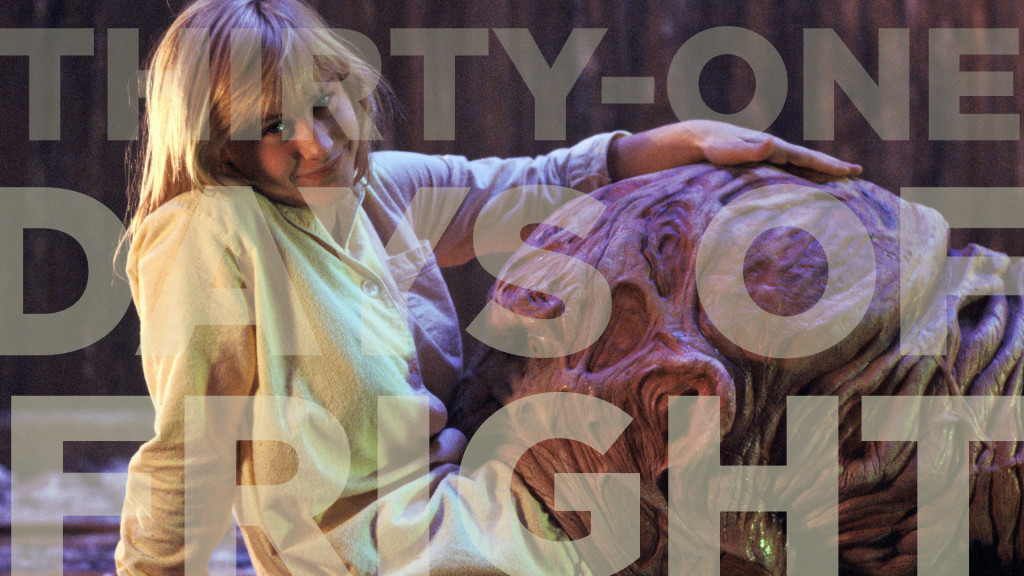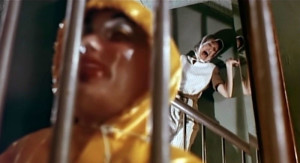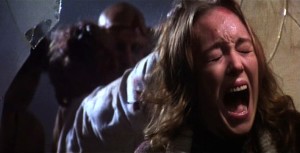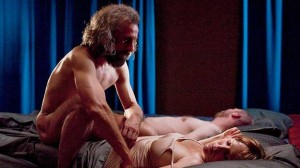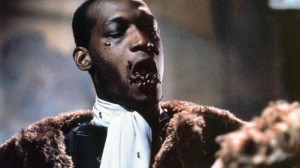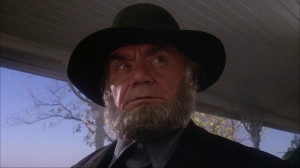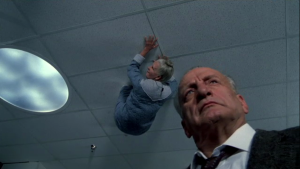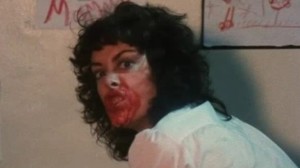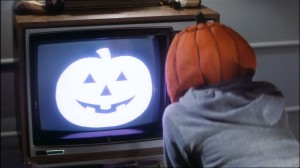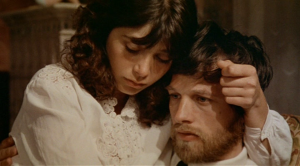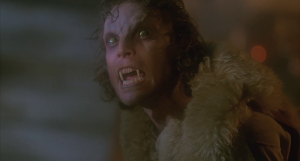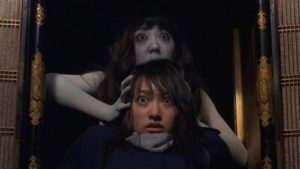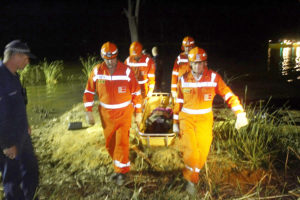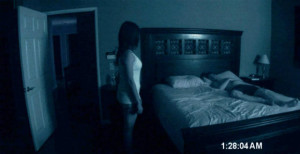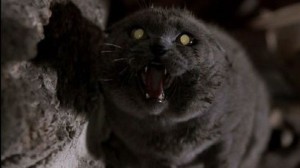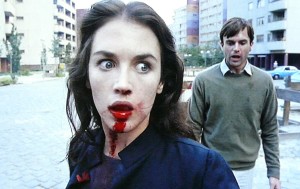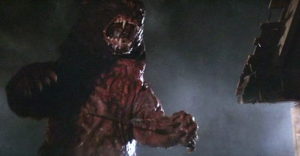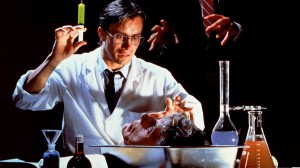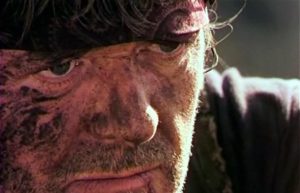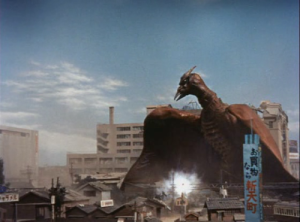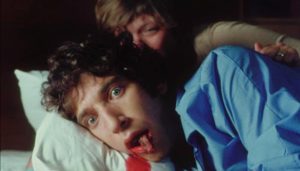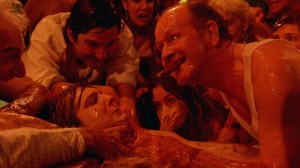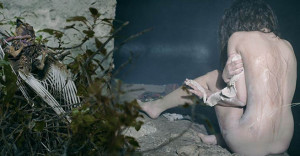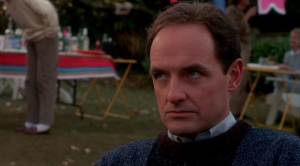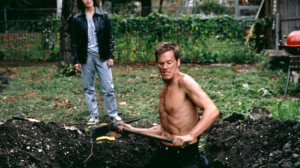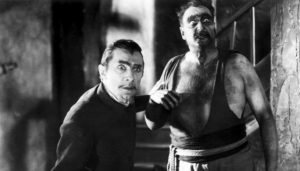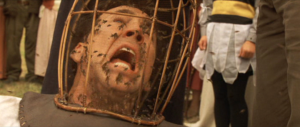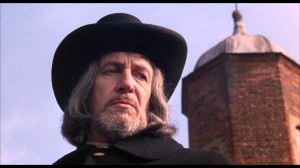
Find witches, get money. That’s Matthew Hopkins’s motto.
This January, in support of the Toronto Rape Crisis Centre / Multicultural Women Against Rape, friends and family have raised over $1,000, which means I have to watch and write about thirty-one horror movies. I’ll watch (on average) one movie a night, many of them requested by donors, after which I’ll write some things about said movies on this website. Be forewarned that all such write-ups will contain spoilers! Last night’s film was Witchfinder General (also known, for mysterious reasons, as The Conqueror Worm), directed by Michael Reeves (The Sorcerers, She Beast). Witchfinder General was not a donor suggestion, but yet another use of a free movie space in an attempt to represent the proud (?) tradition of British horror film and make sure horror legend Vincent Price wasn’t left out of January’s proceedings. I picked up this film – one Vincent Price considered his best work – from Queen Video.
What happens:
Are you ready for a depraved British movie about witch hunts? I hope so, because that’s what’s in store with 1968′s shocking (and disheartening) Witchfinder General! The film opens as a man constructs temporary gallows on a windswept lee. In town, a mob has apprehended an old woman and they drag her screaming into the field as the local priest recites scripture. They carry the woman to the gallows and she promptly passes out, but the priest instructs the mob to revive her by splashing her with a pail of water – I suppose so she can be conscious at the time of her death. With a nod of the priest’s head, the woman is hanged.
A voice-over notes that the year is 1645, the place: England. The English Civil War is raging on, with King Charles I’s Royalists battling Cromwell’s Roundheads. And in the midst of such governmental chaos, a figure like Matthew Hopkins, a lawyer, has become largely free to run amok over East Anglia (an area mostly controlled by Cromwell’s army). Hopkins (Vincent Price) preys on local superstitions in the region to hunt out witches for the magistrates of various municipalities. But before we meet Matthew Hopkins, we first encounter a troop of Parliamentarian soldiers, ambushed by a few Royalist snipers. A few Royalists remain in East Anglia, hiding and scrounging for food. One sniper kills a Roundhead, and the remaining soldiers go in search of the hidden enemy troops. They leave our hero, Richard Marshall (Ian Ogilvy) to watch over the horses.
Marshall is left with the horses and dead soldier’s body for quite some time. He hears screams and gunfire, but his fellow troops eventually return safely. However, one of the Royalists was merely wounded, and he crawls over to the Roundheads, aiming his pistol at their Captain. Marshall fires his gun over his commanding officer’s shoulder, killing the wounded enemy soldier and saving the life of Captain Gordon (Michael Beint), not to be confused with Captain Gorton of fish stick fame. The troops move onward, eager to get to their two days’ leave. Fellow soldiers like Swallow (Nicky Henson) joke with Marshall about his girlfriend, Sara Lowes, as they ride home.
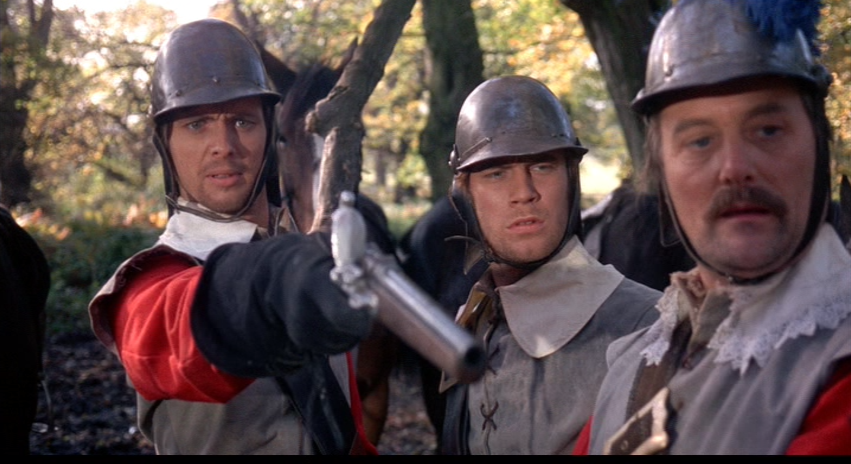
Richard Marshall, quickest draw in East Anglia.
Richard Marshall returns to his village of Brandeston and is greeted by John Lowes (Rupert Davies), Sara’s uncle. Lowes is suspiciously eager for Richard and Sara to wed, and he tries to find out if Richard would take Sara away from their village when they do marry. He is frightened to have his niece stay in Brandeston. Young Sarah (Hilary Dwyer) arrives, and Uncle John leaves the couple to reconnect. Richard informs Sara that her uncle has agreed to their marriage and they kiss. Maybe a little too passionately: “The army has taught you rough manners,” Sara comments. Richard is curious as to why her uncle is so afraid. Some of the Brandeston locals have apparently threatened the family for being papists. Over that night’s dinner, Uncle John again reiterates that their wedding should happen soon. Before leaving the couple, he reminds Sara to lock the doors carefully. Sara and Richard then retire for some hot-and-heavy pre-marital bliss.
Cut to Matthew Hopkins (Vincent Price), riding alongside his assistant, John Stearne (Robert Russell), on their way to Brandeston to investigate accusations made against a local priest. Stearne comments that witchfinding is quite the profitable profession – they receive silver for every hanging – but Hopkins is adamant they are merely doing God’s work. A clear divide is established between Hopkins and Stearne immediately – the meticulous Hopkins is insulted when Stearne uses his first name: “Don’t call me Matthew. I’m not one of your drinking cronies, wenching in the tavern.” While Stearne seems to take pleasure in being paid for his natural inclinations toward torture, Hopkins sees himself as part of a higher mission.
On Marshall’s way out of town, he runs into some villagers on the road, waiting for “Matthew Hopkins, a lawyer.” He meets the finely attired lawyer and his brutish-looking assistant further down the road, thinking not much of it. (I mean, who cares if a lawyer visits your hometown?) However, Hopkins is no regular lawyer – he’s a witchfinder! And the villagers bring him to the priest they suspect of witchcraft: John Lowes, Sara’s uncle! Stearne, with the help of a local mob, begins the witch analysis by stripping Lowes of his shirt and stabbing him in the back with his knife. If the Devil has marked him, he will not bleed, nor feel pain. While all the stabbing is going on, a sympathetic villager summons Sara. Noting that “Satan has hidden his mark well,” Stearne then moves to exhausting the priest, having two volunteers run him around the table.
Sara runs to the church, but Matthew Hopkins intercepts her. He asks if she’s the priest’s niece; if so, she may also be tainted by the Devil. Sara pretends to be a “foundling,” a servant of John Lowes whom he raised, but not a blood relation. Realizing there may only be one way to save her uncle’s life, she offers Hopkins a grim deal: if he releases John Lowes now, Sara will tell him about his innocence in private this evening. (Though in this sentence, “tell him about his innocence” should be read as “offer herself sexually.”) Hopkins returns to Stearne and instructs him to end the interrogation and bring the priest to jail. The interrogation can continue in the morning.
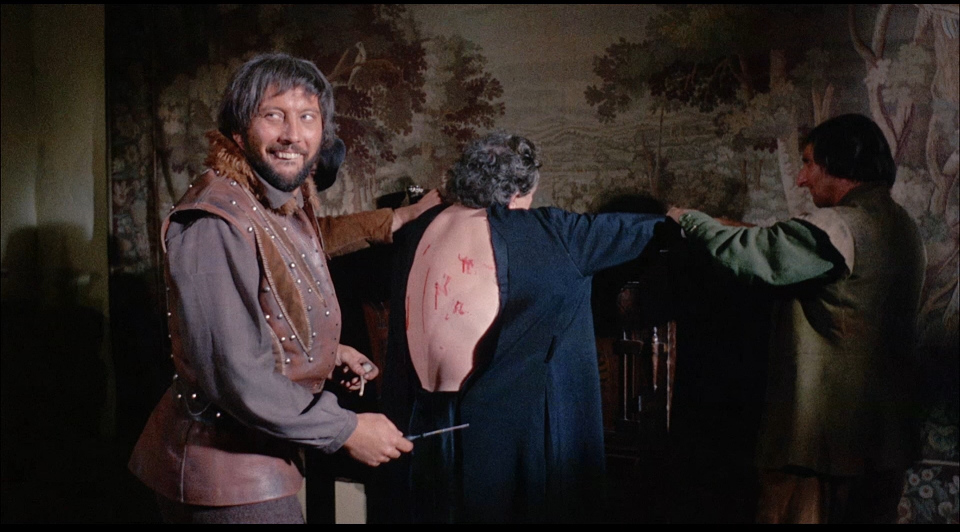
John Stearne is a man who appreciates the value of a hard day’s work.
Stearne heads to the tavern, where he immediately sets to work getting drunk and pouring drinks on unsuspecting women. Hopkins, meanwhile, visits Sara. “Men sometimes have strange motives for the things they do,” he tells her as he begins to take off her clothing. He says that the priest is an idolator and must be killed. Sara begs that Lowes just remain imprisoned for life and presents her body to the witchfinder as a bargaining chip. The next morning, Hopkins kicks awake Stearne, passed out on the barroom floor, and tells him John Lowes will be left in his prison cell. Stearne, subhuman that he is, eagerly asks, “When do we interrogate the women?” That night, Stearne, suspicious of Hopkins’s changed mind, follows him to Sara’s house and uses a conveniently placed ladder to spy on them through the upper window. Suddenly, he realizes why his boss has become so lenient.
The next morning, Stearne is busy slapping an accused witch bloody in a neighbouring jail cell to John Lowes. Hearing the woman’s cries, Lowes vainly pleads for them to stop. Hopkins arrives to check on Stearne’s work – “I trust you were using the prescribed methods” – and tells his assistant that he must travel to the next village over. Stearne implies that Hopkins has become frequently absent recently, but despite this insubordinance, Hopkins leaves the sociopathic Stearne in charge in Brandeston. (Obviously, this is not going to work out well for Sara.) Nearly the minute Hopkins leaves, Stearne accosts Sara while she tends geese in the field, and – I think we can assume, though it happens (mercifully) off-screen – rapes her while a local witchfinder lackey, Salter, watches.
When Hopkins returns to Brandeston, Salter informs him of Stearne’s actions. As a result, Hopkins finds his assistant in the tavern and tells him he’s changed his mind about the priest: they should kill him. Stearne beats the priest in his jail cell until he and the assembled witnesses pretend they hear him confess communion with the Devil. And, in a repeat of the intro, a mob led by Hopkins and Stearne drags John Lowes and two women through the town. Sara, viewing the scene from her bedroom, weeps for her uncle. The mob brings the accused witches to the town moat. The suspected witches will be tied and dumped into said moat. If they sink in the water, their confessions are false. At least they died good Christians. If they swim or float, that proves they’re witches and they must be hanged. They dump the three into the water while Hopkins makes a face of moderate concern.
The moat is about as deep as the shallow end of a community pool. One woman drowns. “She was innocent,” Hopkins says. (Which is kind of his way of saying “my bad.”) The other two swim and must be hanged. “God forgive you, Matthew Hopkins,” the accused priest yells. Hopkins and Stearne hang the two now-proven witches and collect their fee from the magistrate. Meanwhile, Richard Marshall has been tasked with collecting more horses for Cromwell’s army. The horsemaster he encounters, learning he’s from Brandeston, notes that town has been the site of some commotion: they just killed two women and a priest. Marshall, realizing the priest must be his future uncle-in-law, rides his horse at full speed back to the village. When he arrives, he finds a distraught Sara, clad all in black. They collapse on the church floor in an embrace, right in front of a wall graffittied with the word “WITCH.”
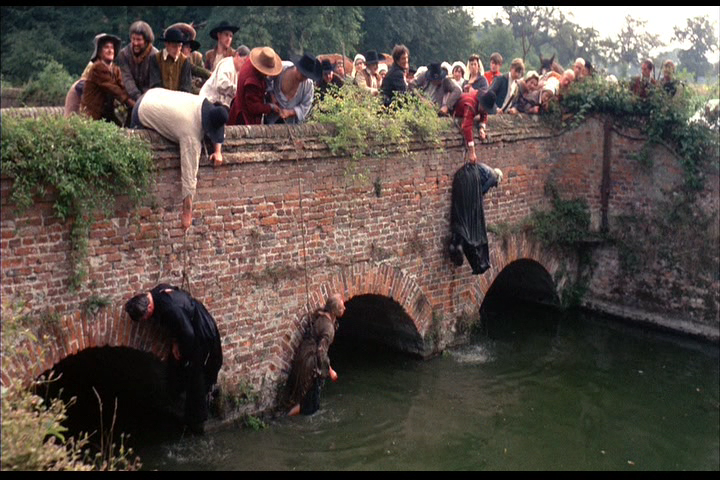
In East Anglia, they never really got the hang of a fishing derby.
Sara alludes to her sexual assault at the hand of Matthew Hopkins and John Stearne. Richard Marshall takes her by the hand and they kneel before the church altar. Richard then marries Sara and himself (I’m not sure if he’s authorized to do that), and swears to God that he will hunt down John Lowes’s murderers. He leaves his new bride in tears, and speeds off on his trusty steed, thirsty for revenge. A shepherd who looks like Gandalf from The Lord of the Rings informs him of the direction he saw Hopkins travelling. Marshall stops in at a nearby town’s tavern where Stearne is busy doing his favourite thing: harassing women. Marshall asks the bartender where he can find Matthew Hopkins, and Stearne, overhearing the conversation, tells him that Hopkins has gone to Cambridge, but that he can help him out if he’s got an accusation. After all, Stearne does all the witch “pricking.”
Marshall promptly smashes Stearne across the face with his flagon of ale, announces himself as Sara Lowes’s husband, and a bar-clearing brawl ensues. Our soldier hero has Stearne on the ropes until the bartender sucker-punches him with a cudgel, giving Stearne the opportunity to escape. The bartender then attempts to bring Marshall to the magistrate to arrest him, but Marshall slugs the tavern owner in the gut and hops back onto his horse. An epic horse chase follows, but Stearne establishes a gap between them, so when he runs into Hopkins, they’re able to secret themselves in the forest while the young soldier races past. Stearne informs Hopkins that the soldier chasing him is Sara Lowes’s husband and advises they split up and lay low. Hopkins, however, is not afraid. “Remember our powers. He could be a witch.” With the tacit endorsement of municipal governments to kill anyone under grounds of witchcraft, Hopkins continues about his dark business as usual.
The soldier Marshall returns to his troop, and is reprimanded by Captain Gordon for deserting the army without official leave. However, Marshall won’t be court-martialled because (a) Cromwell’s army needs all the soldiers they can muster for an upcoming offensive, and (b) he previously saved the Captain’s life. Marshall’s army friend, Swallow, expresses his condolences for what happened in Brandeston, but doesn’t know how Marshall will be able to bring Hopkins to justice. He asks what evidence Marshall has that what Hopkins did was illegal. “I have Sara’s word,” he replies. Swallow doubts that will be enough for a magistrate. “There’ll be no magistrate involved,” Marshall menacingly reveals.
Swallow and a few other troops are sent to round up more horses – you can never have enough horses – and they find Hopkins and Stearne, both of whom have pretty sweet rides. They commandeer Stearne’s horse, dragging him off his mount. Hopkins uses the opportunity to flee on his white horse. Swallow pursues him but Hopkins shoots his horse dead and escapes. Stearne, captured by Cromwell’s soldiers, is about to be press-ganged into serving their side in the English Civil War. Unwilling to leave his old job of torturing for a less lucrative and less torture-filled profession, Stearne stabs one of the two soldiers escorting him and runs away. The other soldier shoots the witchfinding assistant in the shoulder and runs after him. Stearne hides in some tall grass and gets the jump on the remaining soldier, stabbing him in the back and dumping his body in a pond.
Hopkins, who can’t even take an afternoon stroll without finding a witch or two.
The wounded John Stearne finds shelter under a tree and uses his knife to remove the shot from his shoulder. (It seems painful.) He blacks out – which he himself would see as a mark of the Devil – and wakes with renewed hatred for his old partner, Matthew Hopkins. Speaking of whom, Hopkins is living in luxury in Lavenhan, where the town’s magistrate, Webb (Peter Haigh) has set him up with some cushy digs while he roots out the witches in their village. The magistrate says there are a bunch of accused witches – all women – and Hopkins instructs him to retrieve the young ones first. (Gross.) Hopkins has thought up a new way to punish witches, which he notes is “a fitting end for all that is foul in womankind.”
Back at the Roundhead camp, they’re entertaining a celebrity: Oliver Cromwell himself (Patrick Wymark) is guest at an outdoor meal (picnic, really) with his commanding officers. They’ve invited one of Captain Gordon’s best soldiers, Richard Marshall, to join them. Cromwell, upon the captain’s commendation, is promoting Marshall to captain. And as captain, he has a special mission for him: he’s to take three men and return to East Anglia, where they are to find King Charles I, currently hiding in the region. Marshall selects his friend Swallow to join his ragtag gang, and Swallow immediately realizes the vengeful Marshall will try to turn this mission into an opportunity to hunt down Hopkins and Stearne. He advises his friend against this course of action, but Marshall is confident he can kill two birds – finding Hopkins and the King – with one East Anglian stone.
The Roundhead soldiers find a fisherman who tells them a man tried to hire a boat to cross the channel to France. They fear this may have been the King, in disguise, and imagine he may have since travelled to Lavenhan. (This will also give Marshall the opportunity to visit his wife Sara, who now lives in that very same village.) The fisherman says that Lavenhan is in the midst of some excitement now, what with all the witch-burning going on. Lavenhan is two days away; Marhsall and his soldiers race to reach the town in time to catch Hopkins.
In Lavenhan, the whole community has come out for the witch-killing. The accused are imprisoned in a sty, where locals poke them with sharpened sticks. Hopkins calls for the first witch, Elizabeth Clark (Maggie Kimberly) to be retrieved. Her husband, Paul (Morris Jar), is held back screaming by other villagers. Lavenhan toughs bind the bloody-faced Elizabeth to a scaffolding, then raise it up above a raging bonfire. Slowly the lower her into the flames as she screams in agony. Who should show up in Lavenhan, though, but John Stearne, who is none too excited to see his old business partner. He confronts Hopkins after the first witch is burned and threatens him. Hopkins keeps his cool, telling Stearne he gave them both the opportunity to escape. He suggests Stearne be sensible: he’s saved his share of the money; they can be partners once again. He also informs Stearne that people have taken to calling him the Witchfinder General, and there’s even talk of giving him parliament-appointed powers.
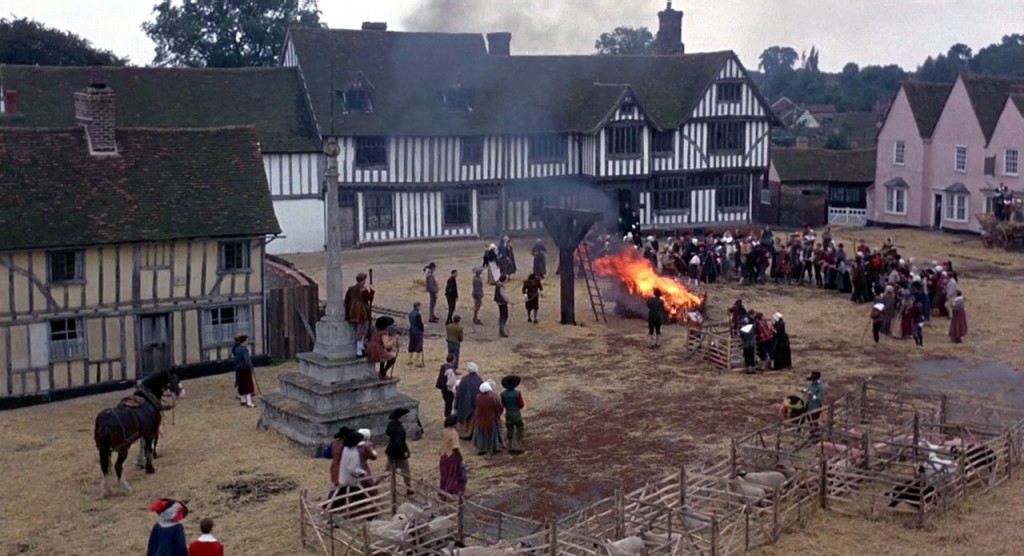
After burning through the witches, Hopkins was said to “slam in the back of his Dragula.”
In the middle of their Sorkin-esque walk-and-talk, they spot Sara in Lavenhan. She hides upon seeing the duo, but they quickly devise a scheme. If Sara is in Lavenhan, the soldier who’s after them must be close by. They can accuse the both of them of witchcraft and end both their lives. Richard Marshall and his fellow soldiers arrive in Lavenhan soon after, and Marshall goes to visit his bride. As they romantically reconnect, Stearne – learning of the soldiers’ arrival in town – warns Matthew Hopkins. Hopkins, realizing Marshall and Sara are alone, without the other soldiers in sight, sends Stearne and the magistrate Webb to apprehend the two of them, with the help of some other local men. Webb accuses the two of witchcraft, saying he saw them speaking with their familiars – a black cat and stoat (!). Hopkins, with the accused brought before him, asks if Marshall has anything to say in his defence. “I’m going to kill you, Hopkins,” he announces.
While this arrest is going down, Elizabeth’s widower arrives with a knife and attempts to kill Hopkins. Hopkins shoots him without hesitation, and Sara and Richard are dragged to the town’s castle. But when you shoot a man, Hopkins, you ought to make sure he’s dead. Elizabeth’s widower just barely survives, and he tells the remaining Roundhead soldiers that their compatriot and Sara were probably taken to the castle for torturing. And torture is exactly what happens. Stearne hangs Sara and Richard by their arms against a dungeon wall and kicks things off by stabbing Sara repeatedly in the back while her husband watches helplessly. Hopkins and Stearne figure that by torturing Sara, they can force Richard to confess to witchcraft. Stearne moves Sara to a table, and Hopkins presents a crucifix-shaped branding iron. If she cries out or faints, he says, that’s just a sign of the Devil intervening.
Swallow and another solider arrive at the castle, but the bureaucratic sentries won’t let them enter without an order from the magistrate. (Magistrate Webb, by the way, is down in the castle dungeon with a front-row seat to the TortureFest.) The soldiers battle their way inside and rush down to the dungeon. Webb guards the door to the dungeon itself and stabs Swallow with a knife. However, the two soldiers overcome him handily. In the chaos, Richard manages, from where he’s hanging on the wall, to kick Stearne in the face, then free himself. With Stearne prone on the floor, he stomps hard on his eye socket and Stearne screams blue murder.
Richard then grabs an axe and starts hacking Hopkins to death. Swallow and the other soldier enter the dungeon and see the horrific bloodbath. Swallow aims his blunderbuss at Hopkins, still being chopped apart by Richard, and shoots him dead. Richard Marshall, now more animal than man, screams at his friend: “You took him from me!” Swallow crosses himself and asks for God’s mercy on all of them. Sara, still tied to the table, screams manically, and her terrified voice carries through the castle.
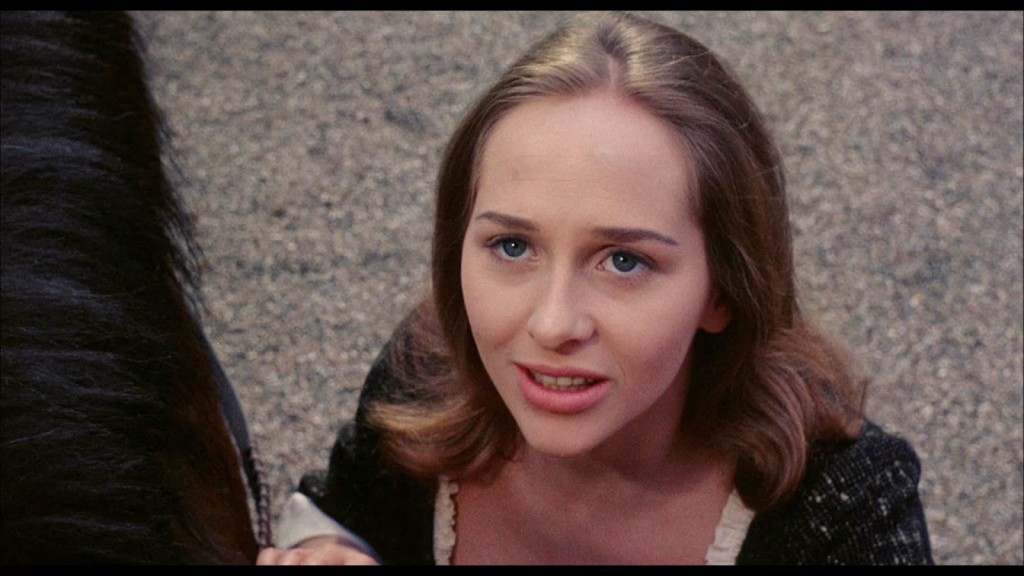
Sara, in much, much better days.
Takeaway points:
- One cannot discuss a movie like Witchfinder General without discussing the idea of a witch hunt in general, and the many connotations that phrase now has. The film depicts the traditional witch hunt, and is quite explicit in how men of authority (a lawyer, sanctioned by local governments) used the idea of witchcraft to take advantage of, then crush women, primarily. Aside from Sara’s uncle, no men are killed in this film for being witches. Hopkins is very clear that women are more frequently tempted by the Devil. The very idea of a witch hunt is that of an advantaged class accusing, then killing the disadvantaged, often using them as a scapegoat for any societal ills. And during the Red Scare, the term “witch hunt” was used to describe the American government’s persecution of suspected communists. (Given the power dynamic, the use of the term is not really inappropriate.) But it is extremely disheartening to see how “witch hunt” is used frequently these days in terms of social media. Often, commenters will describe public shaming of bad behaviour on social media as a “witch hunt,” which I think takes the concept too far out of context to be accurate. After all, usually the figures being shamed are of some authority – brands, celebrities – so the power dynamic is entirely flipped. To use a historical term that describes the governmental persecution of (predominantly) women, for instance, to describe media persecution of Bill Cosby, seems inappropriate, at best.
- Witchfinder General is guilty of the unfortunate use of rape or sexual assault as plot device to propel the male protagonist forward. Sara’s repeated assaults serve only to crystallize a mission for Richard Marshall. Marshall had no real thoughts towards witchfinders in general (pun intended) until his wife is molested by both the witchfinder and his assistant. Just as in Death Wish, the sexual violence does not develop the female character as much as it does the male. While not unexpected – this was made in 1968, and the practice is still very commonplace in film and television – the use of sexual violence does provide a nice scene of Richard Marshall demonstrating how men can actually help by believing women. When his friend Swallow asks how he can prove that Hopkins did anything illegal, he simply responds, “I have Sara’s word.” This is basically the hashtag #BelieveWomen in 17th-Century form.
- Though some critics have praised the historical accuracy of Witchfinder General – namely in its depiction of life in 1645 – there are some real divergences form the real story. Namely that Matthew Hopkins died in his twenties, so it is a bit odd to have the then-56-year-old Vincent Price portraying him. But part of what is so chilling is that Hopkins was a real person, and in under two years, he allegedly condemned 300 people (mostly women) to death. Given that the death count for all English witch trials is estimated to be fewer than 500, Hopkins was a very effective witchfinder.
- When Witchfinder General was first released in the United States, it was given the confusing title, The Conqueror Worm. Confusing as there is no worm – conquering or otherwise – featured or even mentioned in the film. The film was given the new title to try to connect it with Roger Corman’s Vincent Price films (most of which were Edgar Allan Poe adaptations). In the American version of the film, there is a voiceover with a reference to the Poe poem, “The Conqueror Worm.”
- Witchfinder General was the final film of the young director Michael Reeves. Reeves, an up-and-coming horror director, died of an accidental barbiturate overdose just months after the film’s release, at the age of twenty-five.
Truly terrifying or truly terrible?: Witchfinder General is terrifying in its unflinching look at witch hunts and at how cheap human life was during this period in England. The film is harsh – so much so that is was accused of “gratuitous sadism” by the British papers at the time. As Films and Filming said upon its release, “Witchfinder General is emphatically not a horror film; it is, however, a very horrifying one.” The film makes you more afraid of the human race than it does of ghosts or monsters under the bed.
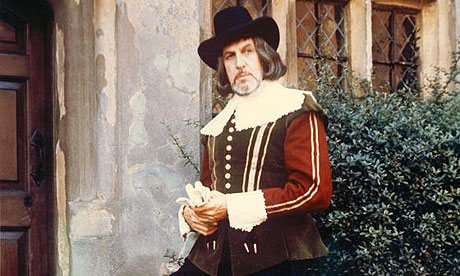
Just because it’s hard work finding witches doesn’t mean Matthew Hopkins needs to dress like a day labourer.
Best outfit: The Witchfinder General himself, Matthew Hopkins, is meticulously dressed in cloak and pristine white gloves. His fashions serve to depict him as a man obsessed with luxury and comfort, all at the expense of the suffering villagers accused of witchcraft. His natty appearance – paid for in blood silver – contrasts with his depraved soul. And of those natty outfits, his Christmas-themed red-and-green tunic is probably the best.
Best line: “Witchfinding? That’s nice. That’s very nice.” – horse trader making small talk about occupations with John Stearne
Best kill: Matthew Hopkins is such an irredeemable figure that you nearly shout with glee when Richard Marshall starts to hack him apart with an axe. Of course, seconds after he does, you realize that Marshall and Sara will never be the same after their ordeal, so Hopkins’s death is cold comfort. But in the moment, it’s nice to see Hopkins on the receiving end of an axe attack.
Unexpected cameo: One of the women in a tavern abused by John Stearne is model and actress Margaret Nolan, perhaps best remembered as the gold woman from the title sequence of James Bond film Goldfinger!
Unexpected lesson(s) learned: Oliver Cromwell’s Roundheads were constantly short of horses. Also, literally every fisherman and horse trader in rural England knows exactly which villages to visit to catch all the best witch hunts.
Most suitable band name derived from the movie: Witchfinder General is already taken by a British metal band. As a backup, Cromwell’s Picnic is also a very good band name.
Next up: V/H/S (2012).
